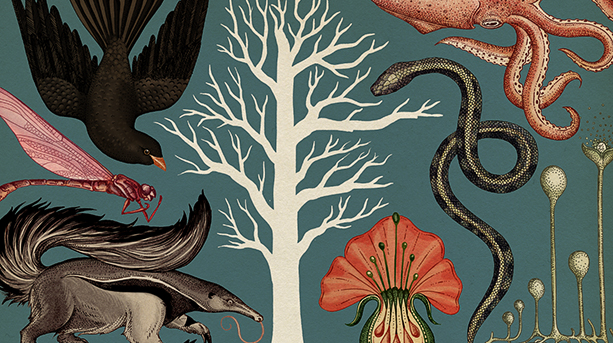Animal Copies Reveal Roots of Individuality
Benjamin de Bivort’s lab at Harvard University is Groundhog Day for fruit flies. In de Bivort’s version, a fly must choose to walk down a dark tunnel or a lighted one. Once it has made the choice — THWOOP! — a vacuum sucks the fly back to the starting point, where it has to decide again… and again… and again.
The contraption, which tracks scores of individual flies, makes it possible to analyze how behavior varies from fly to fly. What de Bivort found when he first used it surprised him: The animals’ behavior varied much more than he expected, even when the flies were more or less genetically identical and raised under the same conditions. “If you hold genetics constant and the environment mostly constant, you still see a lot of variation,” de Bivort said.
De Bivort and his team are now exploring this phenomenon in detail, hoping to discover what drives that unexpected individuality. He’s found that different fly strains show different levels of variability. Some strains are like a troop of well-trained soldiers, with each fly mirroring its neighbor. Other strains resemble a wild group of dancers, with individuals moving to their own beat. By comparing soldier and dancer strains, de Bivort thinks he’s identified both a gene and a neural circuit that may underlie some of these differences.
“They are suggesting that variation itself might be a genetic trait,” said Gerd Kempermann, a neurobiologist at the German Center for Neurodegenerative Diseases in Dresden. “That’s a new and interesting twist.” In other words, natural selection might sometimes favor genetic variants that produce a mix of behaviors — the wild dancers — over variants that create the same outcomes.
Katherine Taylor for Quanta Magazine
Video: De Bivort’s team developed a device called the fly-vac to study individual behavior. Upon entering a chamber, the fly must choose to walk toward the light or dark end. A vacuum then sucks it back to the starting point, and it makes the choice again.
De Bivort’s work is part of a larger effort to understand why nature produces so much variability. Is it merely a side effect of the random mutations that affect all living things? Or does natural selection reward variability and favor mutations that produce it? A diverse population might be more likely to survive changing conditions. A stand of trees that seeds at different times during the season is more resistant to an early frost or late rains than one that disperses all its seeds at once.
“Whether variance itself is a trait that can vary among individuals or genotypes has important implications and is potentially fascinating, but is very difficult to study,” said Alison Bell, a biologist at the University of Illinois, Urbana-Champaign. Comparing genetically identical, or almost identical, lines of flies, as de Bivort is doing, “is really the best tactic for getting at this question.”
A Bad Breed
Buff Orpington chickens are the lapdogs of the chicken world, known for their extreme friendliness. But the breed occasionally hatches an ornery clucker, much to breeders’ dismay. The Buffs aren’t alone. This kind of variation is widespread on both the farm and in the lab. Scientists breeding mice or flies for research have encountered similar problems — even highly inbred fruit flies raised under well-controlled conditions vary in their behavior. Despite researchers’ best efforts to contain it, individual variation persists.
“To most people, it’s an error bar in experiments,” de Bivort said. Scientists routinely include large numbers of animals to smooth out the noise from individual differences.
Where most scientists see a problem, de Bivort saw opportunity. Focusing on groups of animals rather than individuals ignores reams of potentially interesting information. For example, imagine a group of flies that, on average, fly toward the light or the dark in equal proportion. This behavior could be because individual flies have no preference, choosing each option at random. Or individual flies might have strong preferences, with the overall group composed of 50 percent light lovers and 50 percent dark lovers.
De Bivort’s team set out to distinguish those possibilities using a series of devices designed to track individual behavior. The Groundhog Day gadget — officially called the fly vac — contains 32 chambers. Each chamber monitors a single fly. Automatic tracking tools capture data on a variety of behaviors, such as the preference for light or dark, the time it takes to make a decision, and the fly’s overall activity level. Over the course of a two-hour trial, each fly can make up to 40 choices. The experimental ensemble provides researchers with an enormous amount of data.
In another device in de Bivort’s lab, a fly wanders through a tiny Y-shaped maze, choosing at the Y’s vertex whether to walk left or right. A tray of mazes under the watchful eye of a camera enables researchers to study scores of individual flies simultaneously as each walks the maze over and over. With these tools, variation “becomes a biological phenomenon, rather than a side effect or problem,” Kempermann said.
Katherine Taylor for Quanta Magazine
Video: This array of Y-mazes allows researchers to track individual behavior in many flies simultaneously. As the fly walks around the maze, it must decide whether to turn left or right.
De Bivort’s group analyzed “handedness” — a preference to turn left or right — in 150 different strains of flies. They found that some strains vary a lot from fly to fly, with lefties, righties and everything in between. Other strains had much less variation, with individuals that showed only mild preferences for left or right. De Bivort concluded that one source of variation must be hardwired into fruit flies’ DNA.
Missing Ingredient
What distinguishes high variability strains from more uniform varieties? The researchers identified several candidate genes that are active in the brain, including a gene called teneurin-A. When Julien Ayroles, a researcher in de Bivort’s lab, blocked that gene during flies’ development into adults, variation increased. Groups that started out more ambidextrous developed a range of preferences for left and right. The findings support the idea that specific mutations create variability.
As Ayroles searched for genetic clues, Sean Buchanan, another researcher in the lab, began to inspect the brain. He used a series of genetic engineering tricks to boost or dampen the activity of specific neurons, looking for resulting changes to the animals’ handedness. Buchanan found that he could boost variability by manipulating a specific set of neurons in the brain region called the central complex. This region is essential for processing sensory information and controlling movement.
In addition, teneurin-A is expressed in this part of the brain and is required for it to form properly. That fact suggests that two factors — teneurin-A and the central complex — somehow work together to boost variation, although it’s not yet clear exactly how.
De Bivort has some ideas, though. Scientists know that teneurin-A helps to determine how neurons wire together. Imagine the process as a color-coding scheme, where teneurin-A changes the color of a neuron, and neurons can only connect to other neurons of the same color. If you have two sets of three cells — red, yellow and blue — there’s only one possible configuration. But if another version of teneurin-A turns all six cells red, they can connect in a number of ways. In this way, teneurin-A could create the possibility for novel neural wiring even in genetically identical individuals.
Early Influences
What might work like this reveal about the nature of individuality in humans? At this point, it’s not clear. “The fly brain is not as plastic as the mammalian brain,” Kempermann said, meaning that neural wiring in mammals is much more flexible, changing in response to an individual’s experiences. “Much more of [the fly brain] is hardwired.”
In humans, of course, the environment that a person is raised in plays a huge role. De Bivort’s team did their best to rule out such variability. They standardized the flies’ living conditions, going so far as to raise some animals in isolation to eradicate differences in their social lives. (They also minimized genetic differences by using inbred fly strains.)
Despite these precautions, it’s possible that small, difficult-to-detect changes in genes or the environment might contribute to variation. For example, chance events early in development may trigger divergent behavior. Perhaps one egg got a bit more food than another; that small difference could expand over time. Assuming that flies had an identical upbringing is like “saying human twins had the same experiences up until adulthood,” said Judy Stamps, a biologist at the University of California, Davis.

A study in mice, published in Science in 2013, shows just how profound early differences can be. Kempermann and collaborators raised mice of the same strain in the same environment, one full of interesting places to explore and objects to play with. Over time, the mice developed different personalities. Some animals grew more bold and others more reticent. Though they don’t know the exact source of the differences, scientists theorize that early interactions with certain objects or other mice might launch a positive feedback loop: The bold mouse is exposed to new sensations and becomes even more curious.
De Bivort is running a similar experiment in flies, raising them in a rich habitat and looking for changes in behavior. Preliminary results suggest that enrichment — providing an environment that stimulates the senses — can increase variability in certain ways but not others.
“To me, the question is not why individuals would be different, it’s ‘Why would we expect them to be the same?’” Stamps said. “The only reason you would expect that is if you think genes are the only things that are important.”
Help or Hindrance
For scientists studying individual variation, one of the biggest open questions is why it exists. Is it helpful or harmful to the individual and the population? “We still know very little about the fitness consequences,” said Julia Saltz, a biologist at Rice University in Houston.
Some versions of a gene might simply have bad quality control, pumping out a shoddy and inconsistent product. (Scientists refer to this as developmental instability and generally consider it harmful.) Alternatively, perhaps some variability makes for a stronger strain. “If you are more variable, a predator can’t guess what you are going to do next,” Saltz said.
This latter theory is dubbed “bet-hedging” because it resembles diversifying one’s portfolio to protect against risk. Biological bet-hedging provides a population with a range of behaviors, some of which might cope better with mercurial conditions. For example, a population of flies that can tolerate a range of temperatures is likely to be more successful than one that only prefers hot or cold. Mutations that inherently produce variability are more flexible than those that are hardwired to a specific trait.
De Bivort’s team eventually hopes to test this idea with so-called common garden experiments. They’ll create fly habitats with lots of fluctuations — changes in temperature or brightness — and then assess whether low- or high-variability strains are more likely to survive. “I’m firmly in the camp that some level of bet-hedging is optimal for many traits,” de Bivort said. “Perhaps especially behavioral traits.”
This article was reprinted on ScientificAmerican.com.




